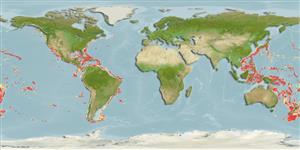Actinopterigi (pesci con pinne raggiate) >
Gadiformes (Cods) >
Macrouridae (Grenadiers or rattails) > Macrourinae
Etymology: Hymenocephalus: Named for its transparent membrane-like head covering (‘‘hymen head’’) and fragile nature of head bones (Ref. 100825). More on author: Gilbert.
Ambiente / Clima / Range
Ecologia
; marino benthopelagico; distribuzione batimetrica 340 - 1348 m (Ref. 58302). Deep-water, preferred ?
Widespread but patchy and discontinuous. Atlantic: Caribbean and continental slope of northern South America. Pacific: off subtropical western and eastern Australia, several islands in the southern Pacific (New Caledonia, Vanuatu, Wallis & Futuna, Marquesas Islands), and off Hawaii. Not recorded from eastern Atlantic nor Indian Ocean.
Size / Peso / Age
Maturity: Lm ? range ? - ? cm
Max length : 20.0 cm TL maschio/sesso non determinato; (Ref. 37108)
Short description
Morfologia | Morfometria
This species is distinguished by the following characters: a black-colored large-headed fish, with head size 21-25% TL; pelvic fin rays 13-14; pectoral fin rays 13-16; projecting snout, 20-24% HL; head bones are papery thin and often distorted; no barbel; small orbit diameter, 20-24% HL; interorbital width 60-70% HW; infraorbital width 20-25% HL; postorbital-preopercular interspace 10-14% HL; preopercular supporter is very small and forked; gill rakers 21-25; ventral striae reaching to about ? from pelvic fin bases to periproct; small otolith with rounded outline, no predorsal lobe developed; colliculi separated; otholith length to height (OL:OH), 1.0-1.2; total colliculum length to pseudocolliculum length (TCL:PCL) is 2.2-2.8 (Ref. 98298).
Found on the continental slope (Ref. 75154). Benthopelagic (Ref. 58302).
Life cycle and mating behavior
Maturità | Riproduzione | Deposizione | Uova | Fecundity | Larve
Cohen, D.M., A.W. Ebeling, T. Iwamoto, S.B. McDowell, N.B. Marshall, D.E. Rosen, P. Sonoda, W.H. Weed III and L.P. Woods, 1973. Fishes of the western North Atlantic. Part six. New Haven, Sears Found. Mar. Res., Yale Univ. (Ref. 37108)
IUCN Red List Status (Ref. 115185)
CITES (Ref. 94142)
Not Evaluated
Threat to humans
Harmless
Human uses
Informazioni ulteriori
Nomi ComuniSinonimiMetabolismoPredatoriEcotossicologiaRiproduzioneMaturitàDeposizioneFecundityUovaEgg development
Age/SizeAccrescimentoLength-weightLength-lengthLength-frequenciesMorfometriaMorfologiaLarveDinamica popolazioni larvaliReclutamentoAbbondanza
BibliografiaAcquacolturaProfilo di acquacolturaVarietàGeneticaFrequenze allelicheEreditarietàMalattieElaborazioneMass conversion
CollaboratoriImmaginiStamps, CoinsSuoniCiguateraVelocitàModalità di nuotoArea branchialeOtolithsCervelliVista
Strumenti
Special reports
Download XML
Fonti Internet
